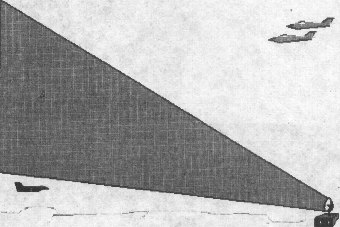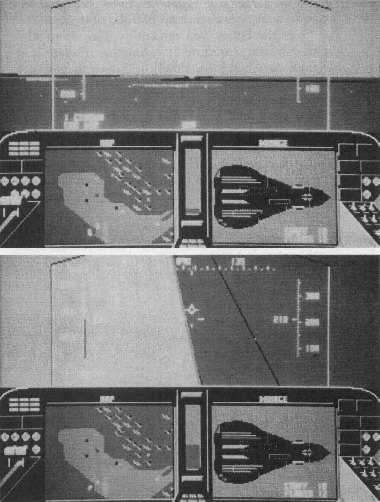The Official F-19 Stealth Fighter Handbook
by Richard Sheffield
Maintaining a Good "Stealth" Profile
Low and slow, smooth and smart. Keep that phrase in mind as you fly. The lower the better; 100 to 150 feet is good. It gets a little rough down there, but extending the flaps will smooth things out somewhat. Use of the flaps may increase your RCS slightly, but when you're down this low it really shouldn't matter.
Your ideal speed will depend upon your situation. When you're not near the enemy, you might want to cruise at high speed to get to the target area faster. But once you begin to close on enemy radar sites or aircraft patrols, slow down. Again, the slower the better. You can cut the throttle to 30 or 40 percent and still stay airborne by extending the flaps and pulling the nose up. Flying this slowly will get you nowhere in a big hurry, but you'll be very hard to spot. By flying low and slow, you'll be able to fly right under many enemy air patrols. But if you're spotted, remember to keep an eye on your airspeed as you respond. Avoid the urge to turn hard and engage the fighters until you add throttle and increase your speed. Turning hard at such a low airspeed without adding power will quickly result in a stall and, if you're at low altitude, this stall will quickly result in a very stealthy smoking hole in the ground.

Staying below 200 feet and under 200 knots will let you pass safely under many enemy air patrols and a lot of radar coverage.
Fly smoothly, and try to avoid steep turns or climbs. Turning hard will greatly increase your radar profile, so take it easy and think ahead. Start your turns early so you don't need a steep angle. This is especially true for flying at a low airspeed.

Fly smart. You're given a great deal of information in the cockpit, so learn to use it. You know that turning will increase your profile, so if you're close to being spotted, time your turn between radar pulses. The situation map and the EMV scale will show each time a radar site pulses toward you. Watch them for a minute to get the period between pulses. This can be very effective when flying near Pulse-type radar sites. These sites can be fooled by flying straight toward or straight away from them. By timing your turn, you can fly deep into the radar coverage area then turn hard between pulses to head away in another direction. Keep an eye on other radars in the area. Don't be so concerned with avoiding one that another sees you in the process. Flying smart means using the terrain as cover when it's available. It may take you out of your way somewhat, causing you to use more fuel, but if you can make the transit safely by flying in a canyon or behind a mountain, you'll likely save fuel: Twisting and turning to avoid SAMs and enemy fighters will burn up a lot more fuel than flying a little farther nice and smoothly behind a mountain.
Table of Contents
Previous Section: F-19 Flight Characteristics
Next Section: Takeoffs and Landings
